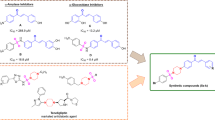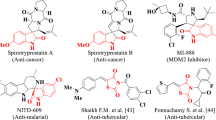Abstract
A series of novel aryl benzylidenethiazolidine-2,4-dione based 1,2,3-triazoles synthesized in a straightforward route consisting of benzylidenethiazolidine-2,4-dione and 1,2,3-triazole pharmacophores. The new scaffolds tested for in vitro antidiabetic activity by inhibition of aldose reductase enzyme and its inhibition measured in half of Inhibition Concentration (IC50). The activity results correlated with standard reference Sorbinil (IC50: 3.45 ± 0.25 µM). Among all the titled compounds 8f (1.42 ± 0.21 µM), 8d (1.85 ± 0.39 µM), 13a (1.94 ± 0.27 µM) and 8b (1.98 ± 0.58 µM) shown potent activity. In addition, molecular docking results against the crystal structure of aldose reductase (PDB ID: 1PWM) revealed that the binding affinities shown by all synthesized compounds are higher than the reference compound Sorbinil. The docking scores, H-bond interactions, and hydrophobic interactions well defined inhibition strength of all compounds.
Graphical abstract









Similar content being viewed by others
References
Patel D, Kumar R, Laloo D, Hemalatha S (2012) Diabetes mellitus: an overview on its pharmacological aspects and reported medicinal plants having antidiabetic activity. Asian Pac J Trop Biomed 2:411–420. https://doi.org/10.1016/S2221-1691(12)60067-7
El-Nashar HAS, Mostafa NM, El-Shazly M, Eldahshan OA (2021) The role of plant-derived compounds in managing diabetes mellitus: a review of literature from 2014 to 2019. Curr Med Chem 28:4694–4730. https://doi.org/10.2174/0929867328999201123194510
Sheikh BY (2016) The role of prophetic medicine in the management of diabetes mellitus: a review of literature. J Taibah Univ Med Sci 11:339–352. https://doi.org/10.1016/j.jtumed.2015.12.002
Magliano DJ, Sacre JW, Harding JL et al (2020) Young-onset type 2 diabetes mellitus—implications for morbidity and mortality. Nat Rev Endocrinol 16:321–331. https://doi.org/10.1038/s41574-020-0334-z
Alexiou P, Pegklidou K, Chatzopoulou M et al (2009) Aldose reductase enzyme and its implication to major health problems of the 21st century. Curr Med Chem 16:734–752. https://doi.org/10.2174/092986709787458362
Maccari R, Vitale RM, Ottanà R et al (2014) Structure–activity relationships and molecular modelling of new 5-arylidene-4-thiazolidinone derivatives as aldose reductase inhibitors and potential anti-inflammatory agents. Eur J Med Chem 81:1–14. https://doi.org/10.1016/j.ejmech.2014.05.003
Chen H, Zhang X, Zhang X et al (2020) Dihydrobenzoxazinone derivatives as aldose reductase inhibitors with antioxidant activity. Bioorg Med Chem 28:115699. https://doi.org/10.1016/j.bmc.2020.115699
Young RJ, Ewing DJ, Clarke BF (1983) A controlled trial of Sorbinil, an aldose reductase inhibitor, in chronic painful diabetic neuropathy. Diabetes 32:938–942. https://doi.org/10.2337/diab.32.10.938
Giugliano D (1993) Tolrestat for mild diabetic neuropathy: a 52-week, randomized, placebo-controlled trial. Ann Intern Med 118:7. https://doi.org/10.7326/0003-4819-118-1-199301010-00002
Asano T, Saito Y, Kawakami M, Yamada N (2002) Fidarestat (SNK-860), a potent aldose reductase inhibitor, normalizes the elevated sorbitol accumulation in erythrocytes of diabetic patients. J Diabetes Complications 16:133–138. https://doi.org/10.1016/S1056-8727(01)00175-1
Akamine EH, Hohman TC, Nigro D et al (2003) Minalrestat, an aldose reductase inhibitor, corrects the impaired microvascular reactivity in diabetes. J Pharmacol Exp Ther 304:1236–1242. https://doi.org/10.1124/jpet.102.044693
Bril V, Hirose T, Tomioka S, Buchanan R (2009) Ranirestat for the management of diabetic sensorimotor polyneuropathy. Diabetes Care 32:1256–1260. https://doi.org/10.2337/dc08-2110
Bouguerra G, Bissinger R, Abbès S, Lang F (2015) Zopolrestat induced suicidal death of human erythrocytes. Cell Physiol Biochem 37:1537–1546. https://doi.org/10.1159/000438521
Ramirez MA, Borja NL (2008) Epalrestat: an aldose reductase inhibitor for the treatment of diabetic neuropathy. Pharmacotherapy 28:646–655. https://doi.org/10.1592/phco.28.5.646
Asati V, Mahapatra DK, Bharti SK (2014) Thiazolidine-2,4-diones as multi-targeted scaffold in medicinal chemistry: potential anticancer agents. Eur J Med Chem 87:814–833. https://doi.org/10.1016/J.EJMECH.2014.10.025
Perike N, Edigi PK, Nirmala G et al (2022) Synthesis, anticancer activity and molecular docking studies of hybrid molecules containing indole-thiazolidinedione-triazole moieties. ChemistrySelect. https://doi.org/10.1002/slct.202203778
Trotsko N, Kosikowska U, Paneth A et al (2018) Synthesis and antibacterial activity of new (2,4-dioxothiazolidin-5-yl/ylidene)acetic acid derivatives with thiazolidine-2,4-dione, rhodanine and 2-thiohydantoin moieties. Saudi Pharm J 26:568–577. https://doi.org/10.1016/j.jsps.2018.01.016
Mehrabani MG, Safa KD, Rahimi M et al (2020) Thiazolidine-2-thione and 2-imino-1,3-dithiolane derivatives: synthesis and evaluation of antimicrobial activity. Pharm Chem J 54:588–595
Bansal G, Singh S, Monga V et al (2019) Synthesis and biological evaluation of thiazolidine-2,4-dione-pyrazole conjugates as antidiabetic, anti-inflammatory and antioxidant agents. Bioorg Chem 92:103271. https://doi.org/10.1016/J.BIOORG.2019.103271
Makiabadi B (2015) Theoretical study of interaction of thiazolidine-2-thione as an anti-thyroid agent with iodine. J Sulfur Chem 36:494–501. https://doi.org/10.1080/17415993.2015.1062097
Jain VS, Vora DK, Ramaa CS (2013) Thiazolidine-2,4-diones: progress towards multifarious applications. Bioorg Med Chem 21:1599–1620. https://doi.org/10.1016/J.BMC.2013.01.029
Chang AY, Wyse BM, Gilchrist BJ et al (1983) Ciglitazone, a new hypoglycemic agent: I. studies in ob/ob and db/db mice, diabetic Chinese hamsters, and normal and streptozotocin-diabetic rats. Diabetes 32:830–838. https://doi.org/10.2337/diab.32.9.830
DeFronzo RA, Tripathy D, Schwenke DC et al (2011) Pioglitazone for diabetes prevention in impaired glucose tolerance. N Engl J Med 364:1104–1115
Wagstaff AJ, Goa KL (2002) Rosiglitazone: a review of its use in the management of type 2 diabetes mellitus. Drugs 62:1805–1837
Fallah Z, Tajbakhsh M, Alikhani M et al (2022) A review on synthesis, mechanism of action, and structure-activity relationships of 1,2,3-triazole-based α-glucosidase inhibitors as promising anti-diabetic agents. J Mol Struct 1255:132469. https://doi.org/10.1016/j.molstruc.2022.132469
Asgari MS, Mohammadi-Khanaposhtani M, Sharafi Z et al (2021) Design and synthesis of 4,5-diphenyl-imidazol-1,2,3-triazole hybrids as new anti-diabetic agents: in vitro α-glucosidase inhibition, kinetic and docking studies. Mol Divers 25:877–888. https://doi.org/10.1007/s11030-020-10072-8
Asgari MS, Tahmasebi B, Mojtabavi S et al (2020) Design, synthesis, biological evaluation, and docking study of new acridine-9-carboxamide linked to 1,2,3-triazole derivatives as antidiabetic agents targeting α-glucosidase. J Heterocycl Chem 57:4348–4357. https://doi.org/10.1002/jhet.4142
Avula SK, Khan A, Rehman NU et al (2018) Synthesis of 1H–1,2,3-triazole derivatives as new α-glucosidase inhibitors and their molecular docking studies. Bioorg Chem 81:98–106. https://doi.org/10.1016/j.bioorg.2018.08.008
Umapathi N, Jalapathi P, Raghavender M, Shankar B (2021) Synthesis of (E)-1-(2, 4-bis ((1-phenyl-1H-1, 2, 3-triazol-4-yl) methoxy) phenyl)-3-phenylprop-2-en-1-one derivatives and their antimicrobial activity. Asian J Chem 33:2341–2346
Aparna Y, Nirmala G, Subhashini NJP et al (2020) Synthesis and antimicrobial activity of novel bis-1,2,3-triazol-1h-4-yl-substituted aryl benzimidazole-2-thiol derivatives. Russ J Gen Chem 90:1501–1506. https://doi.org/10.1134/S1070363220080186
Raghavender M, Kumar AK, Sunitha V et al (2020) Synthesis and cytotoxicity of chalcone based 1,2,3-triazole derivatives. Russ J Gen Chem 90:697–702. https://doi.org/10.1134/S1070363220040210
Vishnu T, Veerabhadraiah M, Krishna Chaitanya V et al (2022) Design, synthesis and anticancer activity of 5-((2-(4-bromo/chloro benzoyl) benzofuran-5-yl) methyl)-2-((1-(substituted)-1H-1,2,3-triazol-4-yl)methoxy)benzaldehyde analogues. Mol Divers. https://doi.org/10.1007/s11030-022-10575-6
Giffin MJ, Heaslet H, Brik A et al (2008) A copper(I)-catalyzed 1,2,3-triazole azide–alkyne click compound is a potent inhibitor of a multidrug-resistant HIV-1 protease variant. J Med Chem 51:6263–6270. https://doi.org/10.1021/jm800149m
Manohar S, Khan SI, Rawat DS (2011) Synthesis of 4-aminoquinoline-1,2,3-triazole and 4-aminoquinoline-1,2,3-triazole-1,3,5-triazine hybrids as potential antimalarial agents. Chem Biol Drug Des 78:124–136. https://doi.org/10.1111/j.1747-0285.2011.01115.x
Kishore Kumar A, Sunitha V, Shankar B et al (2016) Synthesis, biological evaluation, and molecular docking studies of novel 1,2,3-triazole derivatives as potent anti-inflammatory agents. Russ J Gen Chem 86:1154–1162. https://doi.org/10.1134/S1070363216050297
Patpi SR, Pulipati L, Yogeeswari P et al (2012) Design, synthesis, and structure–activity correlations of novel dibenzo[b, d]furan, dibenzo[b, d]thiophene, and N-methylcarbazole clubbed 1,2,3-triazoles as potent inhibitors of Mycobacterium tuberculosis. J Med Chem 55:3911–3922. https://doi.org/10.1021/jm300125e
Kini SG, Bhat AR, Bryant B et al (2009) Synthesis, antitubercular activity and docking study of novel cyclic azole substituted diphenyl ether derivatives. Eur J Med Chem 44:492–500. https://doi.org/10.1016/j.ejmech.2008.04.013
Costa LG, de Laat R, Tagliaferri S, Pellacani C (2014) A mechanistic view of polybrominated diphenyl ether (PBDE) developmental neurotoxicity. Toxicol Lett 230:282–294. https://doi.org/10.1016/j.toxlet.2013.11.011
Zhao L-X, Peng J-F, Liu F-Y et al (2022) Design, synthesis, and herbicidal activity of diphenyl ether derivatives containing a five-membered heterocycle. J Agric Food Chem 70:1003–1018. https://doi.org/10.1021/acs.jafc.1c05210
Viegas-Junior C, Danuello A, da Silva BV et al (2007) Molecular hybridization: a useful tool in the design of new drug prototypes. Curr Med Chem 14:1829–1852
Fraga CAM (2009) Drug hybridization strategies: before or after lead identification? Expert Opin Drug Discov 4:605–609
Nagamani M, Vishnu T, Jalapathi P, Srinivas M (2022) Molecular docking studies on COVID-19 and antibacterial evaluation of newly synthesized 4-(methoxymethyl)-1,2,3-triazolean analogues derived from (E)-1-phenyl-3-(2-(piperidin-1-yl)quinolin-3-yl) prop-2-en-1-one. J Iran Chem Soc 19:1049–1060. https://doi.org/10.1007/s13738-021-02365-y
Vishnu T, Sandhya K, ArunaKumari K, Aparna Y (2023) ANTIFUNGAL ACTIVITY, MOLECULAR DOCKING ON COVID-19 MAIN PROTEASE AND PHARMACOKINETICS OFIMIDAZOLONE ANALOGUES. Heterocycl Lett 13:93–104
Dallakyan S, Olson AJ (2015) Small-molecule library screening by docking with PyRx. In: Methods in molecular biology. Springer, New York, pp 243–250
Trott O, Olson AJ (2009) AutoDock Vina: Improving the speed and accuracy of docking with a new scoring function, efficient optimization, and multithreading. J Comput Chem. https://doi.org/10.1002/jcc.21334
Bhattarai BR, Kafle B, Hwang J-S et al (2009) Thiazolidinedione derivatives as PTP1B inhibitors with antihyperglycemic and antiobesity effects. Bioorg Med Chem Lett 19:6161–6165. https://doi.org/10.1016/j.bmcl.2009.09.020
Mahdavi M, Mohammadi-Izad S, Saeedi M et al (2016) Synthesis and cytotoxicity of novel chromenone derivatives bearing 4-nitrophenoxy phenyl acryloyl moiety. J Iran Chem Soc 13:1139–1144. https://doi.org/10.1007/s13738-016-0828-8
Elancheran R, Saravanan K, Divakar S et al (2018) Design, synthesis and biological evaluation of novel 1,3-thiazolidine-2,4-diones as anti-prostate cancer agents. Anticancer Agents Med Chem. https://doi.org/10.2174/1871521409666170412121820
Sridhar SNC, Bhurta D, Kantiwal D et al (2017) Design, synthesis, biological evaluation and molecular modelling studies of novel diaryl substituted pyrazolyl thiazolidinediones as potent pancreatic lipase inhibitors. Bioorg Med Chem Lett 27:3749–3754. https://doi.org/10.1016/j.bmcl.2017.06.069
Nanjan MJ, Mohammed M, Prashantha Kumar BR, Chandrasekar MJN (2018) Thiazolidinediones as antidiabetic agents: a critical review. Bioorg Chem 77:548–567. https://doi.org/10.1016/j.bioorg.2018.02.009
Day C (1999) Thiazolidinediones: a new class of antidiabetic drugs. Diabet Med 16:179–192. https://doi.org/10.1046/j.1464-5491.1999.00023.x
Türkeş C, Demir Y, Beydemir Ş (2019) Anti-diabetic properties of calcium channel blockers: inhibition effects on aldose reductase enzyme activity. Appl Biochem Biotechnol 189:318–329. https://doi.org/10.1007/s12010-019-03009-x
Kurczab R, Kucwaj-Brysz K, Śliwa P (2020) The significance of halogen bonding in ligand–receptor interactions: the lesson learned from molecular dynamic simulations of the D4 receptor. Molecules. https://doi.org/10.3390/molecules25010091
Tarle I, Borhani DW, Wilson DK et al (1993) Probing the active site of human aldose reductase. Site-directed mutagenesis of Asp-43, Tyr-48, Lys-77, and His-110. J Biol Chem 268:25687–25693
Wade RC, Goodford PJ (1989) The role of hydrogen-bonds in drug binding. Prog Clin Biol Res 289:433–444
Gali S, Raghu D, Mallikanti V et al (2023) Design, synthesis of benzimidazole tethered 3,4-dihydro-2H-benzo[e] [1,3] oxazines as anticancer agents. Mol Divers. https://doi.org/10.1007/s11030-023-10661-3
Mallikanti V, Thumma V, Veeranki KC et al (2022) Synthesis, cytotoxicity, molecular docking and ADME assay of novel morpholine appended 1,2,3-triazole analogues. ChemistrySelect 7:e202204020. https://doi.org/10.1002/slct.202204020
Veeranna D, Ramdas L, Ravi G et al (2022) Synthesis of 1,2,3-triazole tethered indole derivatives: evaluation of anticancer activity and molecular docking studies. ChemistrySelect 7:e202201758. https://doi.org/10.1002/slct.202201758
Veeranki KC, Pochampally J, Maroju RC et al (2023) 1,2,3-Triazoles containing thiazole-piperazine moieties: synthesis, biological assessment and molecular docking. Asian J Chem. https://doi.org/10.14233/ajchem.2023.26904
Stefek M, SoltesovaPrnova M, Majekova M et al (2015) Identification of novel aldose reductase inhibitors based on carboxymethylated mercaptotriazinoindole scaffold. J Med Chem 58:2649–2657. https://doi.org/10.1021/jm5015814
Aitha S, Thumma V, Ambala S et al (2023) Bis 1, 2, 3-triazoles linked deoxybenzoin hybrids as antimicrobial agents: synthesis, in vitro and in silico screening. ChemistrySelect. https://doi.org/10.1002/slct.202300405
Acknowledgements
The authors P. Nagesh and others expressed sincere thanks to UGC, 124257, New Delhi for Financial support. The authors thank the Head, Department of Chemistry, Osmania University, Hyderabad for providing lab facilities. CFRD Osmania University for analytical assistance. We thank DST PURSE for financial support.
Author information
Authors and Affiliations
Contributions
The authors NP, KC, PC and BA carried out all laboratory experiments, prepared the manuscript. KA performed docking studies. The entire work was carried out under the supervision of corresponding author VM.
Corresponding author
Ethics declarations
Conflict of interest
The authors declare that they have no known competing financial interests or personal relationships that could have appeared to influence the work reported in this paper.
Additional information
Publisher's Note
Springer Nature remains neutral with regard to jurisdictional claims in published maps and institutional affiliations.
Supplementary Information
Below is the link to the electronic supplementary material.
Rights and permissions
Springer Nature or its licensor (e.g. a society or other partner) holds exclusive rights to this article under a publishing agreement with the author(s) or other rightsholder(s); author self-archiving of the accepted manuscript version of this article is solely governed by the terms of such publishing agreement and applicable law.
About this article
Cite this article
Patnam, N., Chevula, K., Chennamsetti, P. et al. Synthesis, antidiabetic activity and molecular docking studies of novel aryl benzylidenethiazolidine-2,4-dione based 1,2,3-triazoles. Mol Divers (2023). https://doi.org/10.1007/s11030-023-10674-y
Received:
Accepted:
Published:
DOI: https://doi.org/10.1007/s11030-023-10674-y




